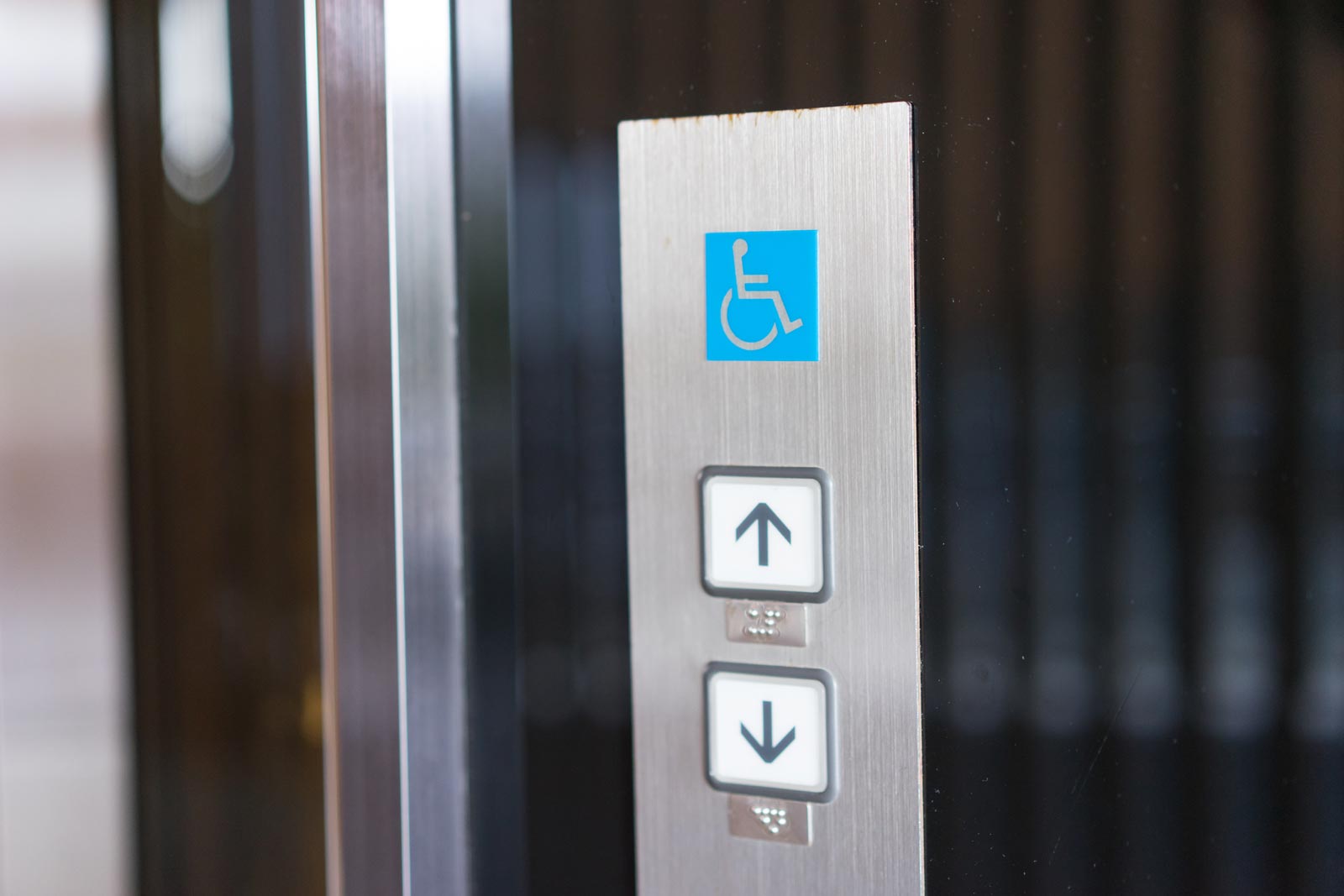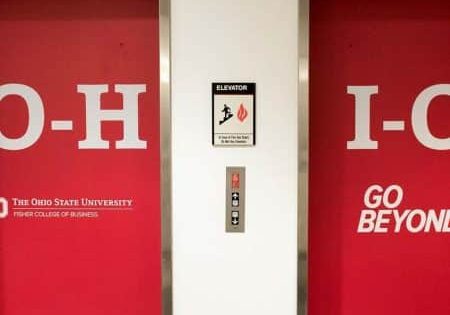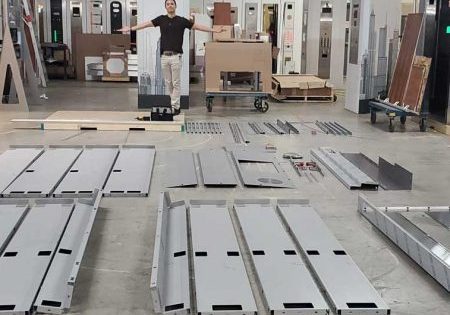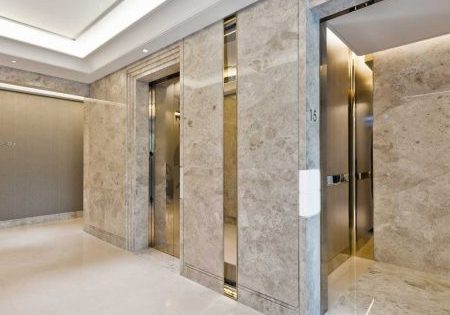Vertical-Transportation Safety Awareness, Inclusiveness and Design Approach Matters in the Global Frame
Jul 6, 2023

by Magdalena Krstanoski
 This paper was presented at the 2022 International Elevator & Escalator Symposium in Barcelona, Spain.
This paper was presented at the 2022 International Elevator & Escalator Symposium in Barcelona, Spain.
Abstract
By utilizing Multi Attribute Analysis, this paper identifies and outlines relevant factors in three fields—safety, inclusiveness and design strategies; in parallel, it emphasizes the importance of synergy in education, risk awareness, regulations and technology on a global scale. At the same time, it investigates factors that can suggest a path to achieve equilibrium among human dimension, the art of perception, cultural spatial relations, the economy and future benefits of new technology that hold promise but also contribute to rising costs for measuring, managing, designing and implementing regulations. Safety is discussed from the perspective of all stakeholders, including the construction industry, taking into account consumer demand and utilization, while a universal message remains for advocating the need for increased global safety awareness in the elevator industry, considering that education, training and safety measures need continuous improvement to reach a long-term solution.
Design is discussed from the end-user perspective. As the average lifespan of the population rises, consumer needs change to include the needs of people with disabilities; special-needs consumers ultimately affect the traditional design of conveying systems. Women were traditionally observed as family caregivers for the elderly and family members with disabilities. In this paper, they reveal another perspective, being the human element with the attributes in the decision-making process who can influence the characteristics of design and management aspects of a conveyance system.
The paper projects two universal messages: First is the need for unification and implementation of a safety protocol on a global scale, regardless of a country’s economy; and second is the necessity of inclusiveness in the industry that will enhance the needs for change considering comprehensiveness and the consumer element, in an attractive and holistic way. All discussed elements, along with the factors that influence each possibility, are solutions for a sustainable future.
Introduction
Over the past two decades, the typical understanding of vertical transportation’s (VT) basic function as a transportation device has changed. VT changed from a commodity to a specialized end-user experience package, particularly in office and mixed-use building developments. This not only represented owners’ intent to obtain a design-driven and sustainable product application versus one with standard features, but it also reflected respective tenants’ preferences and the market trend toward synergy between design, functionality and technology. From the technology side, this includes the facial-recognition feature in destination-dispatch applications, plus the security preference and personalized experience in the commercial segment, where restricted access is a priority and additional features are specified or requested. On the other hand, elevator design in residential buildings has changed very little when it comes to special considerations and front-end design personalization to reflect specific occupancy and users’ interaction. During the pandemic, the residential sector, especially buildings around the world that are not Class A, experienced few changes and little care in comparison to commercial buildings’ elevators and escalators.
At present, in the process of building planning, programming or schematic design, it is either by the owner’s objective or designer’s specific approach when strategies are introduced in building and VT planning, or it is an architect’s initiative to accommodate the needs for people on the autism spectrum in correlation with the owner’s intent or request. Currently, people on the autism spectrum are not addressed in the conveying systems’ planning and building design strategy, but the general design concept has been applied based on building type, occupancy type, specific design criteria and traffic analysis related to building use, project drawings and specifications.
It is more comfortable to initiate new elements that will address socio-cognitive aspects when project objectives are met in new construction rather than in modernization. In existing construction, designers need to accommodate already-built space. On the modernization side, as many elevators are reaching lifecycle curve entering remodeling, typical modernization in most cases includes hoist machine motor replacement; replacement of elevator wiring and car fixtures; door tracks; hoisting cables; brake; cab design; hoistway fixtures; and, depending on the specifications, technology to enhance the travel experience in high-rise office buildings. However, socio-cognitive aspects are not on the priority list.
One of the most challenging tasks of the designer is overbridging the commonality of the minimum required by code regulations, specifying and creating a living responsive structure and VT to satisfy the flow requirements, creating an inviting space to accommodate the occupancy needs via spatial configuration, colors, finishes and introducing natural light and considering temperature, all characteristics that do not specifically include people with autism spectrum disorder (ASD).
Disability, Autism and Design
Children and adults with autism and ASD are facing complex challenges with social interaction; communication; expression; imagination; demonstrating repetitive behavior and preoccupation; sensitivities to certain colors, shapes, textures, sound and change of routine; excessive focus on parts and sometimes details; visual perception; movement repetition; and sensory preoccupation. There are more detailed and explained borders of behaviors, sensitivities and possible reactions noted in various literature and by observation.
ASD’s prominence in society today makes it necessary to address this subject more.
A study published in JRTDD (Journal for ReAttach Therapy and Developmental Diversities, Special Education Research, September 8, 2019) discusses methodology employed via interviews and questionnaires conducted on a limited number of ASD-related participants, leading to various thematic information results. Participants (86.73%) cited anxiety as a frequent challenge. In the same study, results show music therapy (7%) and sensory stimulation (5%), using various lights and equipment, have been identified as two of several measures and approaches to overcome anxiety (Vasilevska Petrovska, I., et al., 2019).
If we reflect on the pandemic, many individuals not on the autism spectrum experienced anxiety. For the first time in recent times, the general population was affected in a way similar to people with ASD, and we learned to better relate to those with this and other conditions.
Man’s evolution has been characterized by the development of “distance receptors” (Hall E., 1966). Distance receptors, along with space and sensory characteristics, became more important than ever in the past year of the pandemic as we learned to have more empathy.
Hall is fascinated by renowned American architect Frank Lloyd Wright’s ability to translate space and texture, as well as his material selection and transitions. Wright is the designer of thousands of structures, among which is the famous Guggenheim Museum in NYC. The Guggenheim has open central space, unique architecture in its interior and a spiral ramp leading to its upper floors that almost feels like it is reaching the sky. If trying to find relation with this structure and the topic of this paper with music, the lyrics of two songs come to mind. The first are those from “Somewhere Over the Rainbow,” sung by Judy Garland in the 1939 classic movie “The Wizard of Oz,” which was adapted from the children’s book by L. Frank Baum first published in 1900. The music is by American composer Harold Arlen with lyrics from Yip Harburg. The song’s opening lyrics are:
“Somewhere over the rainbow, way up high
There’s a land that I heard of, once in a lullaby
Somewhere over the rainbow, skies are blue
And the dreams that you dare to dream, really do come true
Someday I’ll wish upon a star
And wake up where the clouds are far behind me
Where trouble melt like lemon drops
Away above the chimney tops
That’s where you’ll find me”
The second song is titled “Human Behaviour” by Icelandic recording artist Björk from her 1993 album, “Debut.” The lyrics begin:
“If you ever get close to a human, and human behavior
Be ready, be ready to get confused…”
Per the National Center for Educational Statistics (NCES) in 2019/2020, approximately 803,000 individuals ages 3-21 with autism were covered by the Individuals with Disabilities Education Act (IDEA). This is an increase from previous years: in 2018/2019, approximately 762,000 were covered by the IDEA; in 2017/2018, approximately 710,000 were covered; in 2016/2017, approximately 661,000. In 2000/2001, approximately 94,000 were covered (NCES, February 28, 2021).
Per the Centers for Disease Control and Prevention (CDC), based on research conducted across 11 communities/states, one in 54 children aged 8 years in 2016 show ASD prevalence, calculated as the number of children with ASD per 1,000 children aged 8 years in the defined population or subgroup (CDC, 2020). This is an increase from 2014 statistics of 11 communities, showing 1 in 59 children aged 8 years identified on the autism spectrum (CDC, April 27, 2017).
Per Autism Europe, ASD affects approximately 1 in 100 people. This is approximately 5 million people on the autism spectrum in the European Union alone, not including other non-Union members (Autism Europe, About Autism Section, 2021).
People with ASD face many challenges. The sixth sense, the vestibular sense, has been demonstrated as a challenge that can sometimes lead to fear or avoidance of certain activities, such as swinging on swings, descending on elevators or walking uphill (Trajkovski, V., 2020). There have been observed or noted obsessions with elevators, including riding on elevators; fear of exiting tasks that relate to movement; running full-speed uphill, running to climb to the highest spot on the shelf; and the excitement of reaching the top of the hill while running fast.
As no two ASD cases are the same with each expressing different proprioception characteristics, the seventh sense (body position, perception and sense of movement in the space and spatial orientation as a result of the muscle and joints) may result in difficulties with handling small objects, and small elements, or the opposite in being fascinated by the same (ex.: putting together a complex puzzle becomes a task and needs to be successfully resolved).
Other sensitivity areas include auditory (reaction to sound, distraction by sound and background noises, fear of certain sounds); tactile (reaction to temperature, pain, texture); visual (reaction and sensitivity to light and color, likes or dislikes of bright light and colors); and olfactory (taste, reacting to sense of smell, over perceptible or non-perceptible on certain scents and aroma).
Regarding color, certain conditions may create a hyperactive state. In a colorful environment, different types of light create different sensitivity reactions, such as LED versus reflective light. Applying yellow foil to assist with reading and visual processing has been found beneficial (Trajkovski, V. 2020).
As Hall refers to the problem in 1966 as designing and rebuilding cities with an understanding of the needs of a large number of people (Hall, E., 1966), today, 55 years later, the same challenge appears.
One of the most involved steps in the process of VT is to envision the traffic pattern and functionality based on the building occupants. In most cases, we look at conventional characteristics: building type, occupancy type, cultural aspects of the geography, traffic patterns, etc., when we design the conveying system. Accommodating the autistic population in building planning, VT and elevator car design (at times referred to as a small, uncomfortable and even frightening space) is still to be addressed, along with implementing methods to improve the quality of life of people on the autism spectrum and people with disabilities (ex. disabilities not addressed in Southeast Europe, and accessibility in elevators in existing buildings remains an obstacle for people with mobility challenges). Designing VT for individuals with ASD has often or has usually been ignored. At present, there is a lack of regulations to ensure designing spaces and elevators that correspond to humans with ASD. For example, no requirements address specific light in the car (or elevator hall lobby); color and texture of the walls; sound in the car; and the larger personal space that may be needed for autism accommodation.
How can an elevator recognize the need to adapt its inviting space to a passenger with ASD? Should this concept address more residential elevators than commercial building elevators, or is there an equal need across all types?
Autism Europe estimates that less than 10% of people on the autism spectrum across the EU, not including non-Union members, are employed. (Autism Europe, PR: Autism-Europe calls on the EU to better develop access to education and employment Section, 2021).
Elevator design that takes into account the needs of people on the autism spectrum can be more of a subject of interest as the population of people on the spectrum continues to rise at an alarming rate. This needs another look, not only for elevators in residential buildings but elevators in office buildings, as well.
Another consideration should be ways to change car wall interior color and texture. Perhaps this change could be similar to creating a mood with soft, glowing lights that create a relaxing atmosphere in any environment; they get activated after recognizing the passengers’ needs upon their entering the car or calling the hall button, or in the operating car panel. Adding features that can trigger changes in ceiling car light intensity and temperature can make the interior more inviting once passengers on the ASD enter the space. Introducing elevator music that calms anxiety can contribute to the passengers’ riding experience. Covering elevator buttons with yellow foil can enhance the visual processing without affecting the need of people with visual impairment (for example, do this where ADA is applicable to maintain code compliance; otherwise, in other areas where ADA is not applicable, introduce a similar feature for people with visual impairment). The importance of sustainably tailored material, introducing illumination and features are of importance to implement and compliment end-users’ needs and the subject’s specific meaning, functionality and purpose, while balancing with the manufacturer’s objectives, guidelines, processes and introducing cost-effective solutions.
Women are traditionally observed as family caregivers for the elderly, people with disabilities and mostly involved with their children with ASD from the family side. Their input, which included varieties of experiences their children with ASD have, such as sensitivities, reactions and attributes in search for answers, can help researchers understand the complexity of the autism spectrum. This feedback can assist in the decision-making design aspect and characteristics of the success of the application.
Designers, along with the end users, are facing a lot of challenges in influencing decision makers to introduce new elements for inclusiveness of those with ASD and other disabilities, as well as increasing accessibility. Everyone will benefit from the learning process, creativity, innovation and flexibility. At present, there is still a lack of regulatory accessibility implementation around the world to accommodate the aging population and disabled.
Safety Perspective
When we discuss safety applications related to elevators, the first aspect that comes to mind is maintaining, achieving and exceeding safety on the jobsite during construction. The majority of this is driven by jobsite safety initiatives and regulations. A variety of factors affect this: technological changes that introduce new hazards on the jobsite; regulations; productivity demand; labor unions and labor organizations; regulatory agencies; insurance rates in correlation with accident rates; professional ethics and managing construction safety. Maintaining health on jobsites has been even more challenging for construction professionals over the past decade, but, at the same time, working conditions have improved for employees in recent years.
In the U.S., The Williams-Steiger Act, Occupational Safety and Health Act of 1970, states every employee is entitled to a safe and healthy workplace, free of recognized hazards. 29 CFR 1926 is the comprehensive safety and health standard that regulates the construction industry. In some respects, in a similar fashion, the European Agency for Safety and Health at Work introduces European Labor Authority and presents European OSHA for EU members. Other non-EU members adopted and/or introduced safety regulations based on country preference and type of work.
The impact and expense of workplace injuries and illnesses can be categorized as direct and indirect costs, including many factors and related damages to employee, property and equipment, creating direct and indirect consequences. Direct and corresponding damages can include: injury or loss of employee’s life; affected family members; affected coworkers (some feeling it could have been them); litigation; loss of production; wage loss; loss of morale; loss of motivation; increased insurance rates; and the cost to train to replace the injured or affected employee. The overall cost of work-related injuries in the U.S. in 2019 was $171 billion. These costs include lost wages, medical expenses, administrative expenses, fire-related losses, injury investigation time and damage to properties in work-related injuries (National Safety Council (NSC), Work Injury Cost Section, 2021).
Based on the available data related to conveying systems between 2019 and 2020 (OSHA, Accident Search, Section) in the U.S., some of the fatal accidents happened in the following categories (this does not exclude other accidents and probable causes of accidents, but lists some):
- Working on new installation in the elevator shaft, one employee standing on the top of the car, coworker in the basement of the shaft, struck by falling object
- Working in shaft servicing lights, elevator car descending crushing the employee
- Working in the elevator pit, struck by car
- Employee performing service on the existing elevator, crushed between elevator door and gate door
- Fall through the opening of unprotected (unguarded) elevator shaft (either open shaft where elevator had never been installed or other case)
- Working on new installation or renovation working on height, fall from height
- Other trades working on the construction area falling in the elevator shaft
- Hazardous energy lock-out tag-out, de-energizing electrical circuit
- Accidents can be categorized in several groups:
- Accidents that occurred in the elevator shaft (hoistway) on open (not protected) shaft
- Accident that resulted from improperly used personal protective equipment (PPE)
- Not used or properly applied fall protection
- Working with electrical equipment
- Working in the elevator pit
- The effects of the unprotected openings on the floor
- Stuck in between moving objects
- Improper handling and moving of material
- Working with electrical energized circuit
- Use of PPE
Fall protection continues to be a major focus in the industry. Working in or near the shaft, fall protection use is mandatory. These things should be part of the everyday stand-up meeting:
- Proper training on where to tie off
- What is considered a stable structure to tie off
- Where to anchor and where to position in the working area (ex., working as close to the anchor point as possible)
- Consideration for eliminating or minimizing all swing hazards before commencement of the installation
Use of fall protection is required when an employee is exposed to a fall hazard of more than 6 ft (1.8 m) above the ground. It is important to be aware of swing falls, as can happen when the anchor is not directly above the location where a fall occurs and can increase the likelihood of serious injury or death in the event of a fall.
From the end-user side, accidents may occur as a result of the lack of proper maintenance; equipment malfunction and equipment aging; improper use of equipment; equipment not being serviced; and other direct and indirect factors. These accidents may be from elevator door malfunction, sudden start and stop of the elevator, improper leveling, loss of power, stop then start moving again to level on the floor and other factors.
As the aging of elevators in residential buildings becomes evident and a critical path of repair and/or replacement is coming, special consideration must be made on all factors of safety. This is perhaps especially critical in the countries without established protocols, an enforced course of action and regulation. In some countries, there is no strong matrix of jurisdictional requirements or enforced regulations; others lack regulation, resources, responsibilities and follow through. This can well be seen as a hazard waiting to happen. There are several red flags that are applicable in these cases. These red flags include the absence of:
- Educated professionals to recognize the hazard
- An authority that will collect and resolve cases involving older elevators
- Processes, although regulations may exist but not be enforced
- Responsibility, established communication between the building manager and residence with timely response and action (in case of required third party to operate with the resident’s funds for maintenance purposes)
- Allocated critical path funds for maintenance
- A higher authority having jurisdiction to tackle and resolve the subject matter when the building manager is not performing per the agreement
- Technically trained and certified service employee on the market with knowledge of old and new equipment who will timely respond
- An instrument to monitor, enforce and implement resolution, with public safety in mind
Educating and involving the global elevator community in these critical areas in the countries without specified matrix will open a path for bringing global awareness of safety regardless of the region/country, bringing synergy of knowledge, operational practices and education. Education and involvement promise to influence decision-makers that change is a must, and inevitable with proper application and processes, to provide safe elevator rides for the public, especially in aging buildings. Only the industry coming together can influence change.
Conclusion
A long-term synergetic approach to communication among various specialties when designing for people with autistic spectrum is needed. The goal is to deliver a clear message on the importance of the conveying systems and building planning, not only from the aspect of the safety, functionality and compliance with the ADA, but also on the importance of creating a personalized experience for all passengers, including those on the autism spectrum. This is envisioned to provide advancement in elevator planning and design as related to autism in different aspects of the project lifecycle, on the design front and the end users’ experience. Starting from increasing the awareness and then approaching the construction industry with specifics, we can bring more mutual understanding about the challenges and needs of people on the autism spectrum, with the introduction of better sensory integration to improve the customer experience and environment for all. This provides valuable insight on the importance of the complexity in nature of conveying systems’ design and planning, with autism in mind. ASD and accessibility needs (including those of the aging population and those with disabilities) are rising, and we cannot ignore the urgent need to incorporate changes in design to accommodate everyone’s needs.
A long-term synergetic approach across countries to promote safety not only on construction sites, but after elevators are already in service for public use, is urgently needed. The goal is to deliver a clear message on the importance of public safety, along with the conveying systems’ lifecycle and building operation, to implement change on a global scale. A common body of knowledge that will act as an instrument of change is needed to raise awareness and implement action globally.
Disclaimer: The author of this paper bases her research on personal interest and observation and is not giving advice nor acting as an advisor. This paper is solely the result of the author’s personal research, interests and observations and does not represent the opinion of Everglades University.
References
[1] Vasilevska Petrovska, I., Giannakopoulou, C.A., Giannakopoulou, C.A., Winstanley, A., Miletto, R., Constanţa Roşca, G., Ivanova, B., Kaisa, V., and Trajkovski, V. (2019). Environmental Barriers and Facilitators to Participation of People with Autism Spectrum Disorders: stakeholders’ perspective. Journal for ReAttach Therapy and Developmental Diversities. September 8, 2019; 2(1):26- 39. doi.org/10.26407/2019jrtdd.1.19
[2] Trajkovski, V. (2020), Supporting social skills and positive parenting, Manual for parents of children with autism spectrum conditions and professionals in their circle of support, Macedonian Scientific Society for Autism, Skopje, ISBN 978-9989-2106-2-4, Retrieved October 9, 2021, from mssa.org.mk/en/manual/
[3] Autism Europe, Sections: Prevalence rate of autism, PR: Autism-Europe calls on the EU to better develop access to education and employment section, 2021 retrieved October 9, 2021, from autismeurope.org/about-autism/prevalence-rate-of-autism/
[4] Hall, T. Edwards (1966), The Hidden Dimension, Doubleday & Company, Inc. Garden City, New York, Library of Congress Catalogue Card Number 66-11173, Printed in the United States of America NCES. (February 28, 2021).
[5] Number of 3 to 21 year olds with autism served under the Individuals with Disabilities Education Act (IDEA) in the United States from 2000/01 to 2019/20 (in 1,000s) [Graph]. In Statista. Retrieved October 9, 2021, from statista.com/statistics/236348/number-of-disabled-youth-with-autism-in-the-us/
[6] Maenner MJ, Shaw KA, Baio J, et al. Prevalence of Autism Spectrum Disorder Among Children Aged 8 Years — Autism and Developmental Disabilities Monitoring Network, 11 Sites, United States, 2016. MMWR Surveill Summ 2020;69(No.SS-4):1–12. DOI: dx.doi.org/10.15585/mmwr.ss6904a1external icon Retrieved October 9, 2021, from tools.cdc.gov/medialibrary/index.aspx#/media/id/405664
[7] Baio J, Wiggins L, Christensen DL, et al. Prevalence of Autism Spectrum Disorder Among Children Aged 8 Years — Autism and Developmental Disabilities Monitoring Network, 11 Sites, United States, 2014. MMWR Surveill Summ 2018;67(No.SS-6):1–23. DOI: dx.doi.org/10.15585/mmwr.ss6706a1external icon. Retrieved October 9, 2021, from cdc.gov/mmwr/volumes/67/ss/ss6706a1.htm?s_cid=ss6706a1_w#suggestedcitation
[8] NSC National Safety Council, Sections: Work Injury Costs; Accident Facts Retrieved October 11, 2021, from injuryfacts.nsc.org/work/costs/work-injury-costs/
[9] OSHA, Accident Search, Retrieved September 27, 2021, from Source: osha.gov/pls/imis/accidentsearch
Get more of Elevator World. Sign up for our free e-newsletter.









